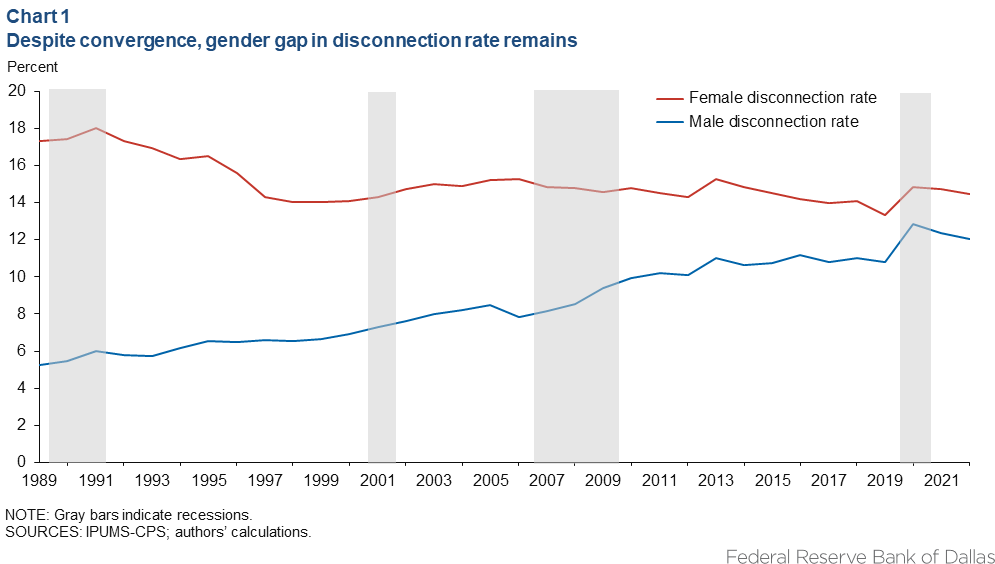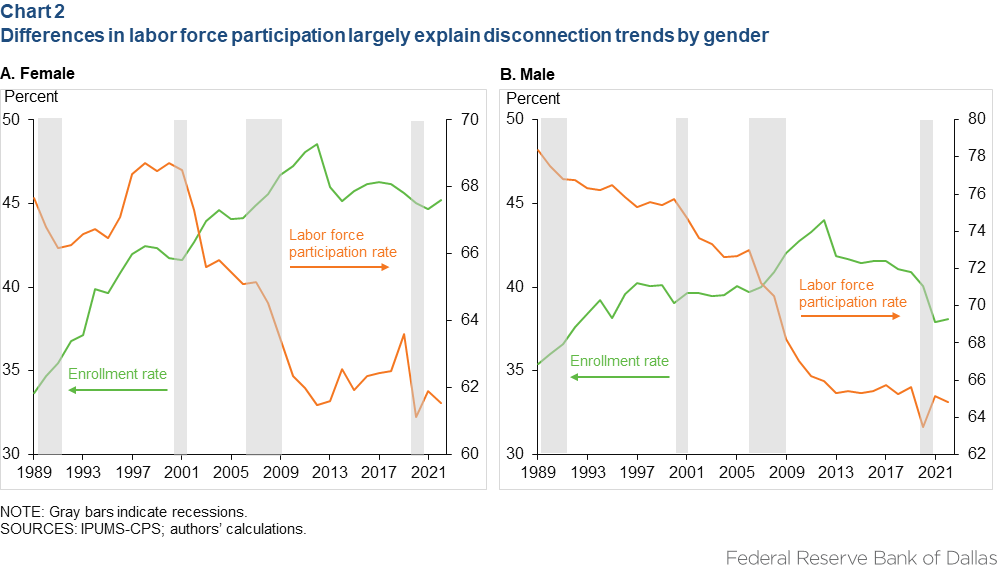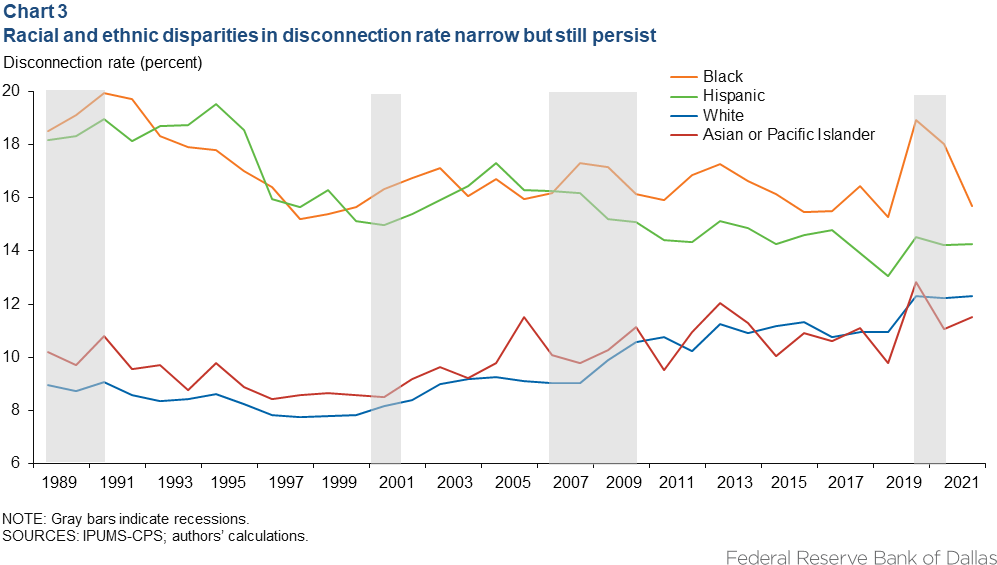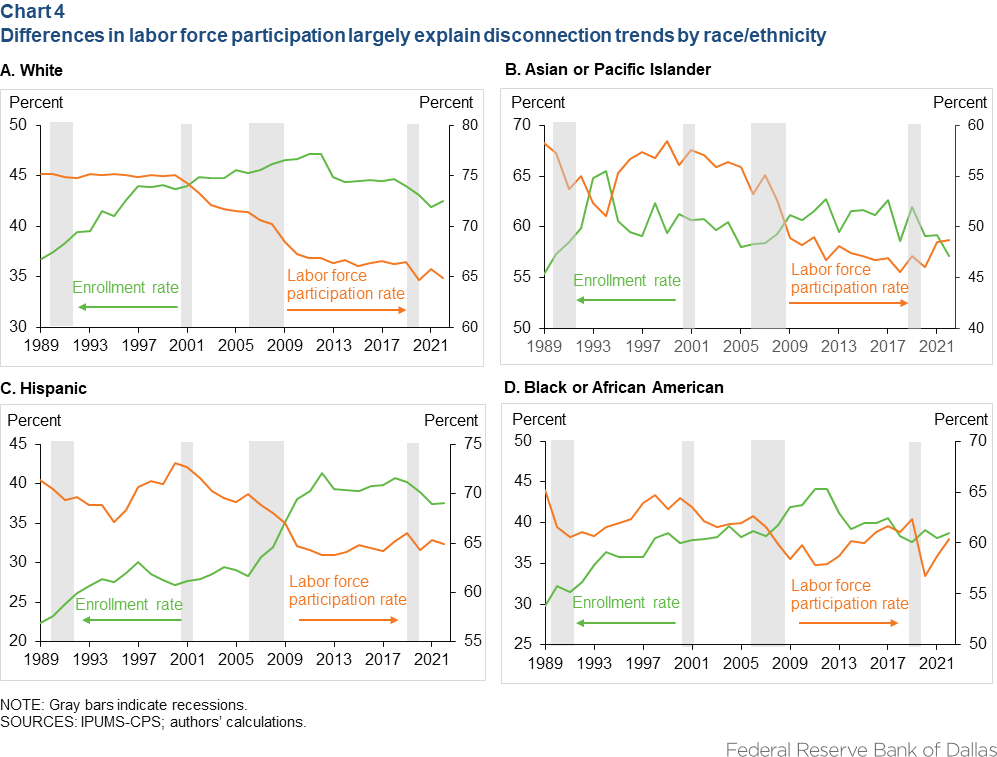
Demographic disparities among disconnected young adults persist but are narrowing over time
The issue of opportunity youths—young adults who are neither in school nor working—has been pervasive over the past few decades, although the problem grew more severe during the COVID-19 pandemic. In our first article, we showed how the rate of young adult disconnection ebbs and flows with business cycles as these adults choose to enroll in school or grapple with the realities of the labor market. In this article, the second and last in our series, we shed light on how several demographic groups have differed in their response to business cycles over time and how their disconnection rates have changed in recent years.
Using Current Population Survey data to analyze 18- to 24-year-olds in the United States, we found noticeable trends among certain groups:
- Women have historically had higher disconnection rates—the share of young adults out of the labor force and not in school—than men. However, the gap has steadily narrowed in recent years.
- Similarly, Black and Hispanic young adults have had higher disconnection rates than white and Asian or Pacific Islander young adults, though those gaps are gradually shrinking over time as well.
- The main driver behind changes in disconnection rates (either positive or negative) is fluctuation in groups’ labor force participation. One exception is Hispanic young adults, who have seen greater reengagement through a rising school enrollment rate.
The rise in disconnected youths in recent years could have long-term effects on the economy if not remedied. Those who are unengaged are at risk of having lower lifetime earnings, a greater chance of unemployment and poorer health. Many costs of disconnection, such as those related to poverty or crime, are passed on to the public. Reconnecting these young adults to school or work not only improves their livelihoods but also improves our country’s economic future. The inability to reengage these young adults may also aggravate economic issues already gaining attention, such as declining enrollment in higher education and a languishing labor force participation.
The Dallas Fed previously studied the topic of opportunity youth in a 2019 report. While this series is a continuation of that research, it differs in two important ways. First, this study analyzes a slightly older age group (18–24 years) than the 2019 study, which looked at 16- to 24-year-olds. We also use a stricter definition of disconnection, counting those who are looking for work but not employed as connected (the 2019 report counted these youths as disconnected).[1]Gender
Despite differences in methodology, both our 2019 report and current study show that women and girls are slightly more likely to be disconnected than boys and men. Our latest research shows that in 2022, the disconnection rate of young women was 14.4 percent while the disconnection rate for young men was 12.0 percent (Chart 1).

We analyzed the two gender groups even further by looking at the shares that were either in the labor force (working or looking for work) or in school (Charts 2A & B). This shows us which activity women and men gravitated toward during different business cycles.
The female labor force participation rate, while responsive to earlier business cycles, had been increasing until the 2001 recession before stalling. Female school enrollment had been increasing over time, too. COVID-19 knocked down the gains young women had made in the labor force since 2007 (a topic we explored in 2021), though the pandemic’s impact on female school enrollment was modest.

The rise in male disconnection rates over time is largely attributable to the decline in their labor force participation rate, though a recent decrease in school enrollment certainly played a role in the most recent uptick in disconnection. Young men’s labor force participation rate has been on the decline for decades and took a large hit after the Great Recession—a hit it has not recovered from. Male school enrollment had been declining prior to COVID-19, and the pandemic’s effect on young men’s enrollment rate, in contrast to young women’s, was more severe.
This is in line with existing research marking the decline in male postsecondary enrollment and labor force participation. However, women still have higher disconnection rates than men despite recent improvement. Our analysis also shows that, as of 2022, 18- to 24-year-old women remain twice as likely to be married and more than twice as likely to be parents than their male counterparts—two additional factors that could contribute to disconnection.
Race and ethnicity
A somewhat similar story unfolds when examining disconnection rates by race and ethnicity. While reengagement among Black and Hispanic young adults has improved in recent years, white and Asian or Pacific Islander young adults have seen their disconnection rates rise (Chart 3).[2] Nevertheless, disconnection among Black and Hispanic young adults remains much higher than the other groups. In 2022, the Black disconnection rate was 15.7 percent, the Hispanic rate was 14.3 percent, the white rate was 12.3 percent, and the Asian or Pacific Islander rate was 11.5 percent.

The disconnection rate for white young adults has been on the rise since about 2000. This is mostly attributable to a decline in labor force participation, first prompted during the 2001 recession and then compounded during the Great Recession (Chart 4A ). However, a trend to keep an eye on is white young adults’ school enrollment rate, which has been on the decline since the early 2010s and reached a low point in 2021.
The Asian or Pacific Islander disconnection rate is the lowest among all four racial and ethnic groups, though it has been increasing since 2001. Their labor force participation rate has been decreasing over the same period, suggesting that the rise in disconnection may be driven by the lack of employment or search for work (Chart 4B). However, similar to white young adults, school enrollment reached a historical low for this group in 2022, which could make reengagement even more difficult.

Unlike the white and Asian or Pacific Islander disconnection rates, the Hispanic disconnection rate has been declining over the past two decades. The main driver of this trend is the large increase in the Hispanic school enrollment rate, especially after the Great Recession (Chart 4C). This has made up for a sizeable decrease in the Hispanic labor force participation rate. However, the COVID-19 pandemic made a large dent in the enrollment rate, which did not see a noticeable improvement in the next two years.
The Black disconnection rate, while still the highest among these four racial and ethnic groups, had also been declining slightly since the early 2000s. The five-year average disconnection rate from 2000 to 2005 was 16.4 percent and dropped to 15.8 percent from 2015 to 2019. This phenomenon appears to be driven both by a temporary increase in the school enrollment rate and a relatively robust recovery in labor force participation after the Great Recession (Chart 4D). In fact, Black labor force participation was the only one of the four groups to come close to climbing back to its prerecession rate.
However, among all the racial and ethnic groups, the spike in disconnection after the COVID-19 pandemic was highest among Black young adults (nearly 4 percentage points) compared with Asian or Pacific Islander (3 points), Hispanic (1.5 points) and white young adults (less than 1.5 points). This is driven primarily by the dip in the Black labor force participation rate, which was larger than the dip among other young adults. In the years since, the Black labor force participation rate continues to improve more slowly than other groups, highlighting the inequities in the ongoing economic recovery.
Key takeaways
Our first article concluded that disconnection among young adults has been worsening over time, long before the COVID-19 pandemic exacerbated the problem. This article goes a step further to illuminate the long-term trends among different demographic groups and identify the main drivers behind either disconnection or reengagement.
Despite recent declines in disconnection rates, historically marginalized groups like young women and Black and Hispanic young adults have been and remain more likely to be disconnected from work and school. These trends will continue to be a concern for states in the Federal Reserve’s Eleventh District—Texas, New Mexico and Louisiana—which have relatively high shares of Black and/or Hispanic young adults. Nevertheless, recent improvements in underlying trends such as the rise in Hispanic school enrollment shows that these disparities can be mitigated.
As we’ve shown, young adult disconnection, like many other phenomena, is sensitive to business cycles as well as structural barriers affecting gender, racial and ethnic groups. Knowing this, policymakers and related stakeholders like educational institutions can be proactive; they can develop targeted and efficient ways to invest in reengagement efforts during future economic downturns so as to reconnect young adults to our regional and national economics that benefit from their participation.
Notes
- See the technical appendix for full methodological details.
- In our study, “Black,” “Asian or Pacific Islander” and “white” refer to individuals who do not identify as Hispanic. “Hispanic” individuals in this analysis can be of any race. Due to small sample sizes, we were not able to reliably analyze young adults of other races and ethnicities.
About the authors
The views expressed are those of the authors and should not be attributed to the Federal Reserve Bank of Dallas or the Federal Reserve System.

